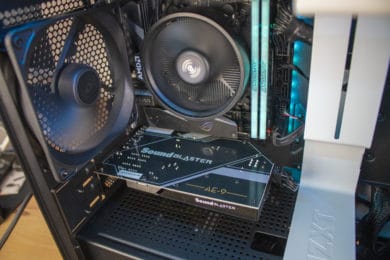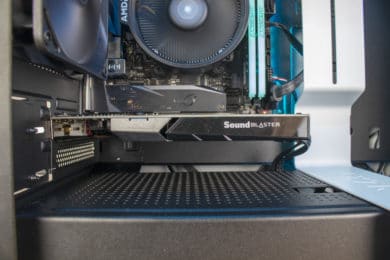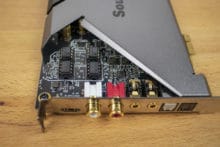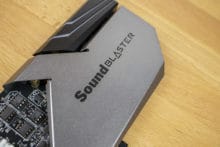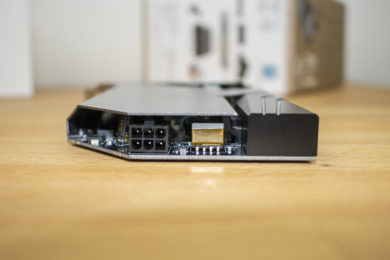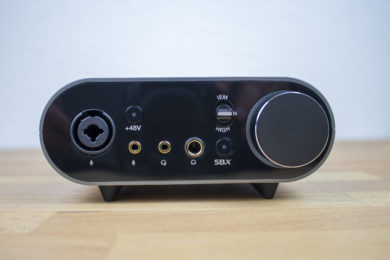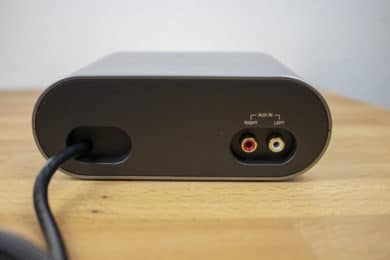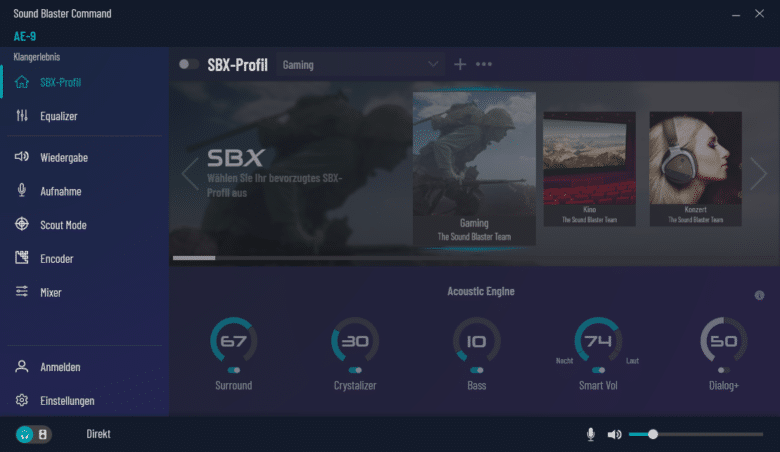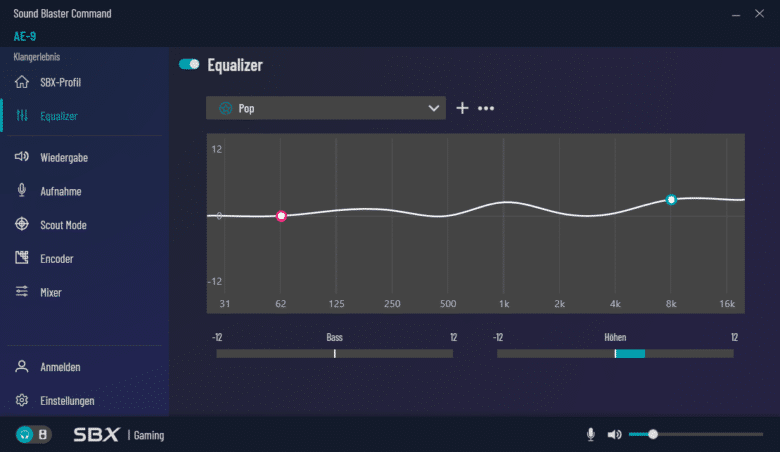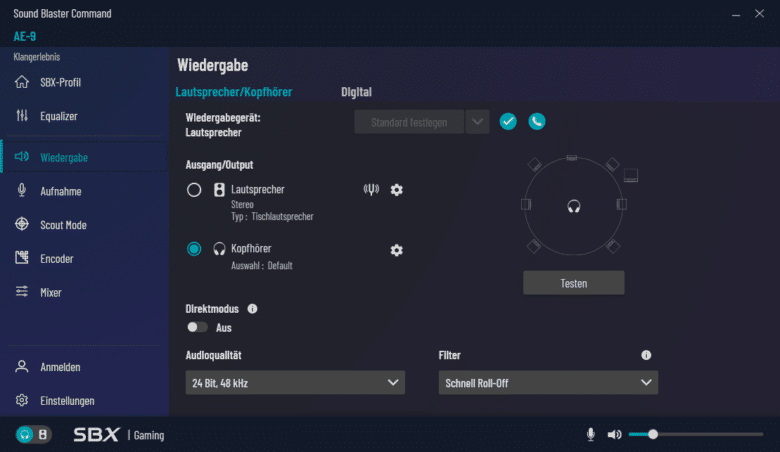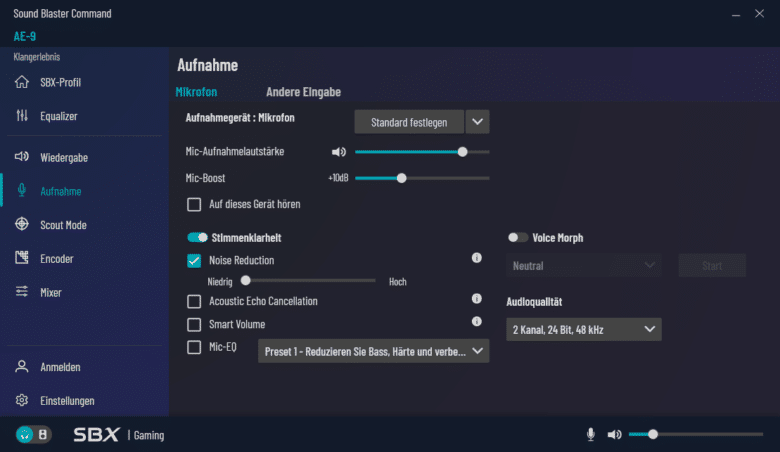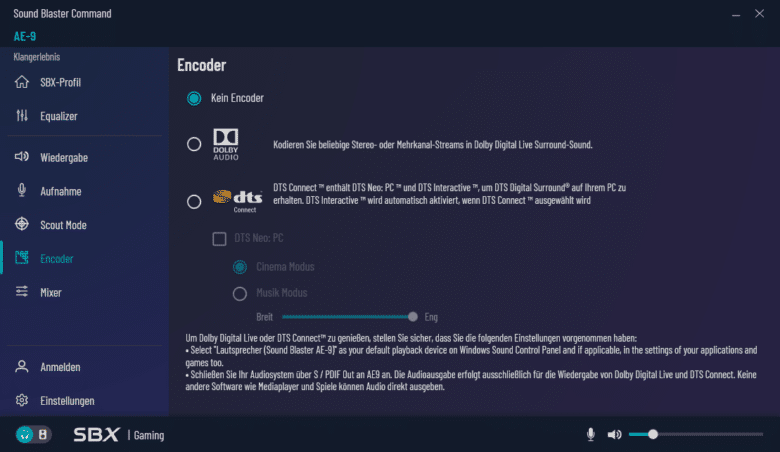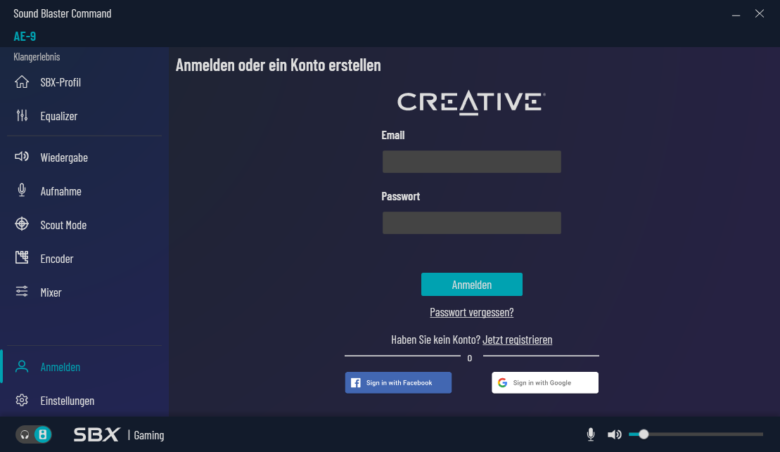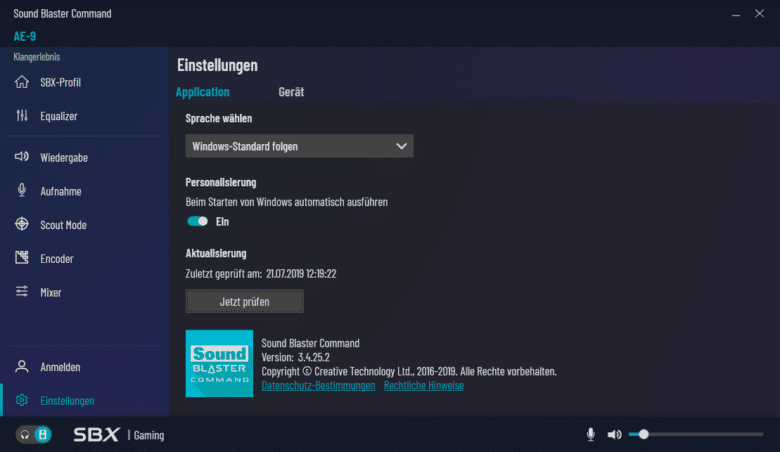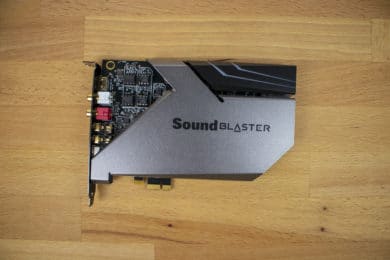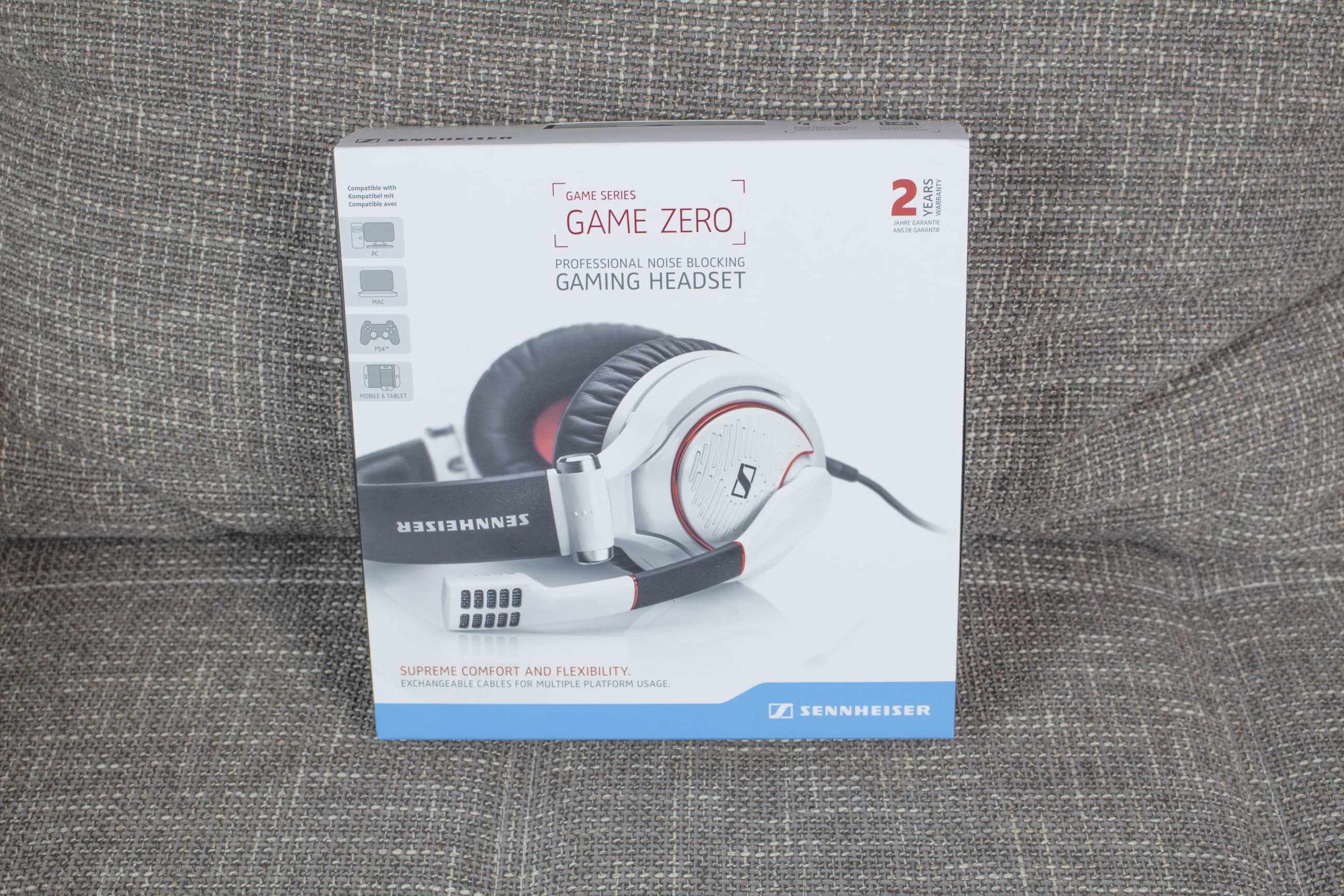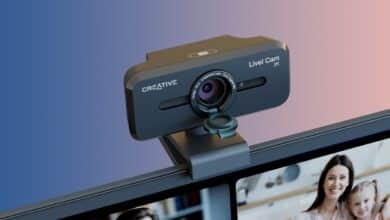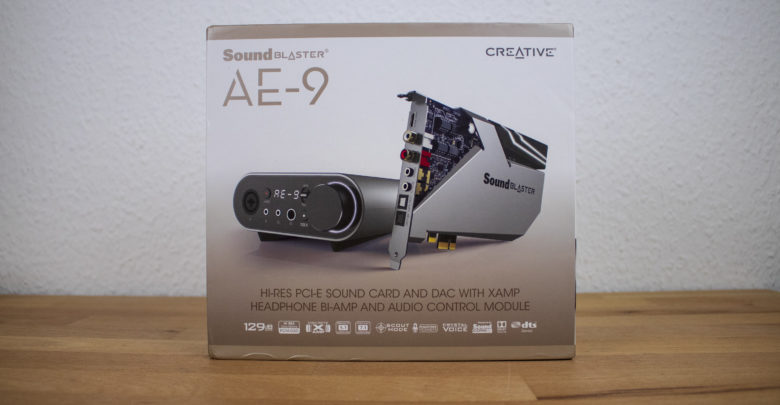
Already 30 years ago Creative Labs presented its first Sound Blaster soundcard. Since then, the manufacturer has rightly made a name for itself in the audio industry. The Sound Blaster AE-9 is a new flagship sound card designed for enthusiasts.
For most PC users and gamers, the onboard sound is good enough, but Creative is not targeting this clientele with the Sound Blaster AE-9. It claims to be the best sound card. It features an ES9038PRO SABRE digital-to-analog converter (DAC) from ESS, eight simultaneous channels for 32-bit audio at 384 kHz and 129 dB SNR (signal-to-noise ratio). The overall harmonic distortion of only 0.0001 percent is impressive. These are impressive values, but note that when using the external audio control module, the signal-to-noise ratio drops to 123 dB and the overall harmonic distortion increases to 0.0004 percent. So if you want to enjoy really good sound, you have to go directly to the sound card on the back of the PC.
In addition, the Sound Blaster AE-9 offers an amplifier for high-end headphones up to 600 Ohm, the channels (left/right) are even separated. The Audio Control module has a three-way switch for different impedance levels, so that simple in-ear headphones can also be connected.
The Audio Control Module, a desktop junction box, also features an XLR connector with +48-volt phantom power for recordings up to 32-bit and 96kHz. Unfortunately, the junction box is only made of plastic, which is cleanly processed.
In addition to the powerful hardware, Creative relies on the Sound Blaster Command software, the many pre-configured equalizer profiles for games and music styles and various other effects such as the Scout mode for gamers and CrystalVoice for voice enhancement and noise reduction.
We found out in our test whether Creative didn’t just deliver on paper, but also whether the impressive numbers are reflected in brilliant sound.
Specifications
| Connection |
PCI Express x1
|
| dynamic range | 129 dB (Stereo, DAC), 123 dB (Stereo, ACM module) |
| Total harmonic distortion |
0.0001% (Stereo, DAC), 0.0004% (Stereo, ACM module)
|
| Playback resolution (DSP Mode) |
16-bit / 44.1, 48, 88.2, 96 kHz | 24-bit / 44.1, 48, 88.2, 96 kHz | 32-bit / 44.1, 48, 88.2, 96 kHz
|
| Playback resolution (Direct Mode) |
16-bit / 48, 96, 192, 384 kHz | 24-bit / 48, 96, 192, 384 kHz | 32-bit / 48, 96, 192, 384 kHz
|
| Recording resolution | Mic Input: 16-bit / 16, 44.1, 48, 88.2, 96 kHz | 24-bit / 44.1, 48, 88.2, 96 kHz | 32-bit / 44.1, 48, 88.2, 96 kHz Aux and S/PDIF Input: 16-bit / 44.1, 48, 88.2, 96, 192 kHz | 24-bit / 44.1, 48, 88.2, 96, 192 kHz What U Hear Input: 16-bit / 44.1, 48 kHz | 24-bit / 44.1, 48 kHz |
| Headphone amplifier |
supported 16 – 600 Ohm Impedance
|
| Connections |
plug-in card:
1x optical TOSLINK input, 1x optical TOSLINK output, 1x 3.5mm rear out, 1x 3.5mm center/sub out, 1x ACM connection, 1x 6-pin PCI Express (PCI-E) power connector (required for ACM), 2x Cinch (L/R) front output Audio Control Module (ACM): 2x RCA (L / R), 1 x 3.5 mm Mic In (mono), 1x 3.5 mm HP output, 1x 6.3 mm HP output, 1x XLR input |
| Power connection | 1 x PCI Express 6-pin (required for ACM) |
| Price |
Connections and Exterior
The Creative Sound Blaster AE-9 is housed in a sleek metal enclosure that is designed to shield against electromagnetic interference. Unlike the Sound Blaster AE-5, the AE-9 does not use RGB lighting, but simply white LEDs.
Creative also plays it safe with the power supply. Instead of getting all the power from the motherboard, which would be a good idea especially with the +48 volt phantom power supply, the sound card has an additional 6-pin PCI Express power connector. This does not necessarily have to be connected, but is necessary if the Audio Control Module (ACM) is to be used. Without the additional power supply, you can only use the connectors directly on the sound card.
The Sound Blaster AE-9 offers what you would expect from a high-end sound card in terms of connections. In addition to two jack connectors, there are also two optical and two cinch connectors. The external audio control module is connected via Mini-HDMI. There are two further cinch and 3.5 mm jack connectors on this module. There is also a 6.3 mm jack connection and an XLR connection. As already mentioned, the XLR connector is equipped with +48 V phantom power, which can also be deactivated.
In addition, there is a volume control, an impedance control, an SBX and a +48 Volt button on the connection box. Press and hold the volume control for two seconds to switch between headphones and speakers. The built-in display shows the volume.
Please note that one of the 3.5 mm sockets on the Audio Control Module is four-pin and can therefore be used for headsets. The simultaneous use of 3.5 and 6.3 mm jacks is not possible, however, as the 6.3 mm jack is then deactivated. The impedance switch is responsible for both connectors.
Software and Options
With the Sound Blaster Command software you can control the sound effects of the AE-9. The software is user-friendly and easy to use. In the following, we will discuss the individual functions.
The SBX profile optimizes the sound for different scenarios such as gaming, cinema or concert. However, it is also possible to make individual settings. In addition to surround sound, there is also Crystalizer to improve voice reproduction or an increased bass level.
Creative also provides several preset profiles for the Equalizer. Here, too, an individual adjustment is possible. From +12 to -12 dB.
In the Playback tab, you can set the output channel (speakers/headphones) as well as the audio quality.
The recording menu item is slightly more extensive than the playback menu item. In addition to the recording volume, annoying noise or echoes can also be reduced. It is also possible to assign a sound effect to your voice and change it accordingly. Of course, the audio quality can also be adjusted.
The Scout mode is especially interesting for gamers, because certain frequencies are highlighted here in order to be able to hear steps or weapon changes better. It is possible to set a hotkey to activate and deactivate the scout mode.
The encoder area is especially interesting for home cinema users. Dolby Audio and DTS Connect can be activated here.
The mixer allows you to adjust the volume of the different channels.
To save your profile, Creative allows you to create an account that will save your settings in the cloud.
In the settings of the Sound Blaster Command Software you can check for updates in addition to the language settings.
Sound
The main reason for buying the sound card is likely to be the outstanding sound it is supposed to provide. Of course, we wanted to find out what the situation was like.
Especially impressive is the bi-amped headphone output, which delivers up to 600 Ohm and can therefore also fire studio headphones. But no matter if you use headphones or speakers, the BlasterX Acoustic Engine DSP offers different sound effects at both outputs, which are interesting for games and movies.
If you use headphones instead of a good 5.1 sound system, it is definitely worth activating the virtual 7.1 surround sound. Because this brings the home cinema virtually upside down and is also a significant improvement for games. You dive much deeper into the action. Of course, you can also switch to the direct mode at any time for an uninterrupted sound experience. Unfortunately, the AE-9 doesn’t offer a native 7.1 sound.
Equally interesting for gamers is the scout mode. Especially for friends of shooters this can bring a small competitive advantage, if you hear your opponents better. The result of the sound editing by Creative is successful and very helpful. The same goes for the other sound effects, where everyone has to decide for himself whether he wants to use them or not. After all, they change the original sound.
For popular games like CS:GO, PUBG and Dota 2 there are already premade profiles, it would have been nice to have an automatic profile change as soon as the respective game is recognized. Other peripheral manufacturers already manage that.
If you don’t just want to gamble, you can also rely on high-quality encoders that offer excellent sound. Integrated are DTS, Dolby Digital, Dolby Digital Live as well as DTS Digital Surround Encoding in stereo or multi-channel.
We liked both the sound effects and the direct mode of the Sound Blaster AE-9 very much, in the sound reproduction the sound card is absolute top class.
Microphone
The integrated XLR/TRS combo jack with +48 volt phantom power gives you a lot of hope. The AE-9 could also be a good solution for streamers or podcasters. However, those who really want to rely on high recording quality will not be satisfied. Don’t get me wrong. For the average user the recording quality is already top and more than sufficient, gamers will be absolutely satisfied. Nevertheless, you will hear a low noise when listening closely and no studio quality will be achieved. So if the recording quality is the focus when you buy a sound card, you should rather look for another solution.
Conclusion
All in all, Creative has introduced the Sound Blaster AE-9, another high-end sound card that convinces with various sound functions.
The playback can trump with an excellent audio quality. Despite the phantom power supply, which looks good on paper, the recording performance of the sound card is not exceptional, but rather average. Anyone who places a high value on playback quality will be absolutely satisfied. If, on the other hand, you attach importance to the recording quality, you should look for another or additional solution.
We can recommend the sound card to audiophiles and gamers despite the criticism of the recording quality. It is worth the comparatively high price of 350 Euro.
Creative Sound Blaster AE-9
Workmanship
Sound Quality
Recording Quality
Features
Value for Money
A highly recommended high-end sound card when playback quality is more important than recording quality.
